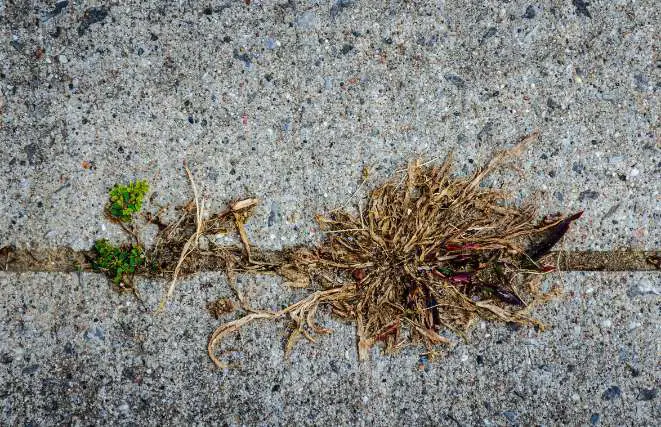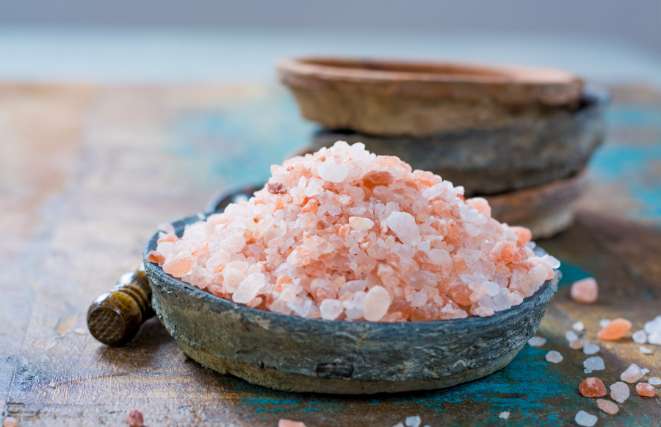Pampas grass can be a stunning addition to any landscape, but it can also become invasive and difficult to control. If you’re dealing with an overgrown pampas grass problem, you might be wondering if rock salt can be an effective solution.
So, will Rock salt kill pampas grass? Rock salt can be an effective method for killing pampas grass. When applied to the roots or around the base of the plant, the salt draws out moisture from the grass, dehydrating it and eventually leading to its demise.
In this blog, we will delve into the topic and explore the effectiveness of rock salt as a pampas grass killer. We will also discuss alternative methods for removing pampas grass and provide guidance on their safe and effective use. Whether you’re a landscape designer, garden designer, or a beginner gardener, this article will equip you with the knowledge to tackle pampas grass and restore balance to your outdoor space.
Understanding Pampas Grass
Pampas grass (Cortaderia selloana) is a perennial grass native to South America. It is known for its tall stature, reaching heights of up to 10 feet or more, and its striking plume-like inflorescences that can be white, pink, or purple. While pampas grass is appreciated for its aesthetic appeal and ability to create natural privacy screens, its vigorous growth and extensive root system make it a challenging plant to control. Without proper management, pampas grass can quickly spread and outcompete native vegetation, disrupting local ecosystems.
Characteristics of Pampas Grass
Pampas grass possesses several characteristics that contribute to its invasive nature. Understanding these traits can help in developing effective control strategies. Here are some key features of pampas grass:
- Size and Growth Rate: Pampas grass is known for its impressive size, with mature plants reaching heights of 10 to 13 feet on average. It is a fast-growing plant that can establish itself rapidly, leading to the formation of dense stands.
- Rhizomatous Root System: Pampas grass has an extensive underground rhizomatous root system. These rhizomes enable the plant to spread horizontally, sending up new shoots and establishing new colonies. The robust root system makes it challenging to eradicate pampas grass entirely.
- Plume-Like Inflorescences: One of the defining features of pampas grass is its feathery, plume-like inflorescences that appear in late summer or early fall. These attractive plumes contribute to the plant’s ornamental value but can also be a means of seed dispersal, further aiding its spread.
How to Make Your Rock Salt Pampas Grass Killer?
- Understanding Rock Salt’s Impact on Pampas Grass: Before using rock salt to combat pampas grass, it’s essential to understand how it affects the plant. Rock salt dehydrates the plant by disrupting its ability to absorb water, ultimately leading to its demise. However, using rock salt as a pampas grass killer requires precision and caution to prevent harm to other desirable plants.
- Creating a Targeted Application: To effectively use rock salt as a pampas grass killer, it’s crucial to apply it directly to the plant’s root system. This can be achieved by drilling holes into the base of the pampas grass clump and carefully pouring a concentrated rock salt solution into the holes. This targeted approach ensures maximum effectiveness while minimizing the impact on surrounding vegetation.

Check the latest price on Amazon
How to Make a Rock Salt-Based Solution to Kill Pampas Grass?
- Recipe for a Rock Salt Solution: Creating a rock salt-based solution can be an alternative method for killing pampas grass. By combining rock salt with water and a surfactant, you can create a potent herbicidal mixture. However, it’s important to exercise caution when using this solution to prevent harm to other plants and minimize environmental impact.
- Application Techniques: When applying the rock salt-based solution, it’s crucial to follow specific guidelines. Directly spraying the solution on the pampas grass leaves and stalks can effectively kill the plant. However, be mindful of overspray and avoid contact with desirable plants. Additionally, apply the solution during dry weather to maximize its effectiveness.
Does Rock Salt Kill Grass Permanently? How Long Does it Take?
- Limitations of Rock Salt: While rock salt can kill pampas grass, its effectiveness may vary depending on the size and maturity of the plant. Established pampas grass clumps may require multiple applications or alternative removal methods for complete eradication.
- Timeframe for Results: Rock salt may take several weeks or even months to completely kill pampas grass. Patience is key, as the dehydration process is gradual. Regular monitoring of the treated area is essential to gauge the progress and apply additional treatments if necessary.

How to Safely Use Rock Salt to Kill Pampas Grass?
- Protective Measures: When working with rock salt, it’s essential to prioritize safety. Wear protective gloves, goggles, and clothing to prevent skin or eye irritation. Additionally, avoid inhaling the salt particles by wearing a mask or working in a well-ventilated area.
- Minimizing Environmental Impact: While rock salt can be an effective pampas grass killer, it’s important to consider its potential environmental impact. Avoid using rock salt near water sources or areas where runoff may harm aquatic life. Furthermore, limit its application to the target area to minimize its spread and potential harm to beneficial plants.
Is Rock Salt Better Than Roundup?
Rock salt and Roundup (a common herbicide) are different in their approach to weed control. Rock salt acts by dehydrating plants, while Roundup targets the plant’s cellular function. The choice between the two depends on factors such as personal preference, environmental considerations, and the specific weed control requirements.
| Rock Salt | Roundup | |
|---|---|---|
| Mode of Action | Dehydrates plants by disrupting water absorption | Targets plant’s cellular function and inhibits growth |
| Effectiveness | Effective against certain plants, including pampas grass | Effective against a wide range of weeds and plants |
| Time to Kill | Takes several weeks to months | Generally provides quicker results |
| Environmental Impact | Can potentially harm surrounding vegetation and ecosystems if not applied carefully | May have residual effects on soil and non-target plants |
| Safety | Can cause skin and eye irritation if proper protective measures are not taken | Requires caution during application to avoid human and pet exposure |
| Regulatory Considerations | Generally does not require specific regulations for home use | Some formulations may be subject to local restrictions |
| Application | Targeted application required for best results | Spraying directly on foliage and affected areas |
| Suitability | Suitable for specific weed control needs, including pampas grass | Versatile and effective against various weeds and plants |
| Persistence | Not persistent in the soil | May have residual effects in the soil |
| Long-Term Impact | May require repeated applications or alternative methods for complete eradication | Can provide long-lasting weed control with proper application |
Please note that this comparison table serves as a general guide and individual product formulations and regulations may vary. Always refer to the specific instructions and guidelines provided by the manufacturer when using any herbicides or weed control products.
READ: Will Roundup Kill Pampas Grass?
Other Ways to Kill Pampas Grass
| Method | Description | Effectiveness | Time Required | Cost |
|---|---|---|---|---|
| Manual Removal | Physically digging out the plants and roots | Moderate | High | Low |
| Smothering | Covering the area to deprive grass of sunlight | Moderate | Medium | Low |
| Solarization | Using the sun’s heat to kill grass under a plastic tarp | High | High | Low |
| Rock Salt | Applying rock salt to dehydrate and kill the grass | High | Medium | Low |
| Roundup | Using herbicide to kill the grass | High | Low | Medium |
Please note that the effectiveness, time required, and cost may vary depending on the size of the infestation and the specific conditions of your garden. It’s important to choose a method that suits your preferences and aligns with your gardening goals.
MORE: Will Bleach Kill Pampas Grass?
Preventing the Spread of Pampas Grass
In addition to controlling existing pampas grass growth, it’s essential to take preventive measures to limit its spread and establishment in your garden. Here are some key strategies to consider:
- Regular Monitoring: Conduct regular inspections of your garden to identify any new growth or seedlings of pampas grass. Early detection allows for swift action to prevent its establishment and spread.
- Prompt Removal of Seed Heads: Pampas grass produces large plume-like seed heads that can scatter seeds over a wide area. Remove these seed heads before they fully mature to prevent seed dispersal and subsequent growth. Bag and dispose of the seed heads in a sealed container to prevent accidental spread.
- Root Barrier Installation: If you’re dealing with persistent pampas grass that keeps encroaching from neighboring properties, consider installing a root barrier. A root barrier is a physical barrier that prevents the underground rhizomes from spreading beyond a designated area. Consult with a professional landscaper or garden expert for guidance on proper installation techniques.
- Regular Maintenance and Landscape Design: Proper landscape design and maintenance can help deter pampas grass from establishing in unwanted areas. Encourage healthy growth of desirable plants to create a competitive environment that discourages pampas grass colonization. Regularly remove any unwanted grass shoots or seedlings before they become established.
READ: Will Vinegar Kill Pampas Grass?
FAQ
When it comes to using salt to kill pampas grass, rock salt is generally the most commonly recommended type. Rock salt, also known as sodium chloride, is effective in dehydrating and killing the grass. It is readily available and relatively inexpensive. However, it’s important to note that using salt as a herbicide can have long-term effects on the soil’s fertility and overall health. Therefore, it’s recommended to use salt sparingly and only as a last resort when other methods have failed. Additionally, it’s crucial to avoid using salt near desirable plants or in areas where it can leach into nearby water sources.
Yes, rock salt can kill tree roots if it is applied directly to them or if it is used excessively in the soil around the tree. Rock salt contains high levels of sodium, which can dehydrate and damage the roots, eventually leading to their death. However, it’s important to note that using rock salt to kill tree roots is not a recommended or commonly used method. The application of rock salt can have unintended consequences, such as harming nearby plants, affecting the soil’s fertility, and potentially destabilizing the tree’s overall health and stability.
Conclusion
In conclusion, rock salt can be a viable option for killing pampas grass when used correctly and responsibly. By understanding the impact of rock salt on the plant, following appropriate application techniques, and considering alternative methods, you can effectively control pampas grass and restore balance to your landscape. However, it’s important to prioritize safety, minimize environmental impact, and be patient throughout the process. Whether you choose rock salt or explore other methods, the key is to find an approach that aligns with your gardening goals and helps maintain the beauty and health of your outdoor space.









